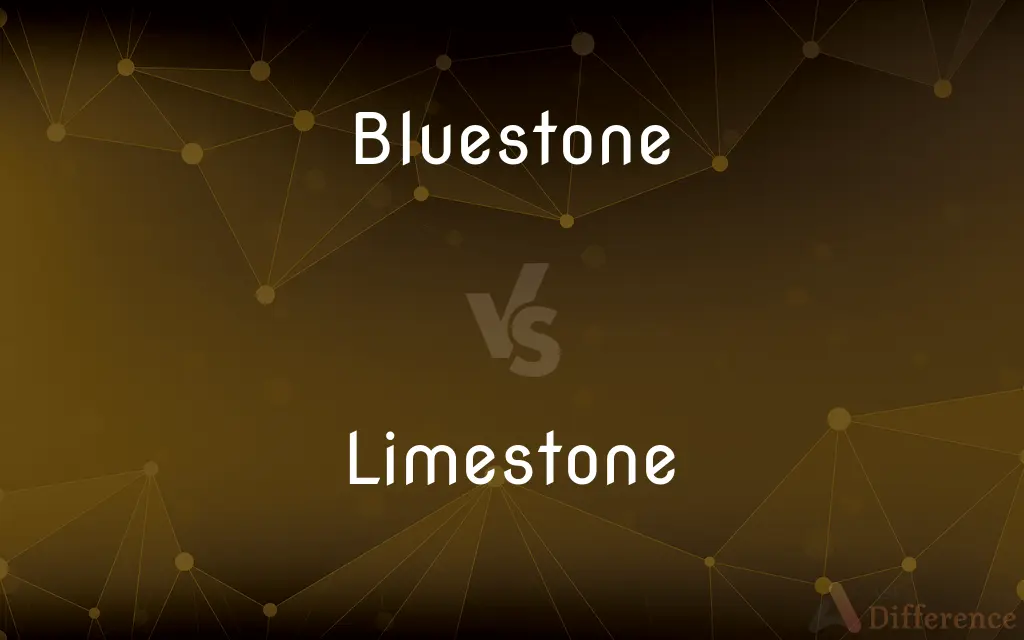Bluestone vs. Limestone — What's the Difference?
Edited by Tayyaba Rehman — By Maham Liaqat — Updated on April 5, 2024
Bluestone is a dense, durable natural stone with a blue or bluish-gray color, used in outdoor construction. Limestone is a sedimentary rock, often light in color, used for building and as a raw material in cement.

Difference Between Bluestone and Limestone
Table of Contents
ADVERTISEMENT
Key Differences
Bluestone refers to various types of dense, hard stones with a blue to bluish-gray color, including varieties of basalt, sandstone, and limestone. Its durability and aesthetic appeal make it popular for outdoor use, such as in patios, walkways, and walls. Limestone, primarily composed of calcium carbonate, comes in shades ranging from white to beige and is valued for its workability and versatility in construction, including use in architecture, landscaping, and the production of cement.
The color of bluestone is a defining characteristic, offering a unique aesthetic that blends well with outdoor environments. Limestone, while also used in outdoor applications, provides a different palette that includes lighter, warmer tones, contributing to its wide use in both traditional and modern designs.
Bluestone's density and hardness afford it high resistance to wear and weather, making it ideal for high-traffic outdoor areas. Limestone, though durable, is more porous and softer, requiring sealing when used in certain environments to prevent staining and erosion.
In landscaping and architectural design, bluestone is often chosen for its distinct color and texture, enhancing the visual appeal of outdoor spaces. Limestone offers more variety in textural finishes and colors, making it adaptable to various design aesthetics from rustic to contemporary.
Despite their different characteristics, both bluestone and limestone share a common heritage as natural stones used in construction for centuries. Their selection often depends on the specific requirements of the project, including aesthetics, durability, and environmental conditions.
ADVERTISEMENT
Comparison Chart
Composition
Varied (basalt, sandstone, limestone variants).
Calcium carbonate (CaCO3).
Color
Blue to bluish-gray.
White to beige, can have other colors.
Durability
High, resistant to wear and weather.
Durable but more porous and softer than bluestone.
Uses
Outdoor construction: patios, walkways, walls.
Building material, architecture, cement production.
Aesthetic
Offers a unique, natural aesthetic with cooler tones.
Versatile in design, with warmer, lighter tones.
Maintenance
Low; resistant to staining and weathering.
Requires sealing in outdoor settings to prevent stains.
Texture
Dense, hard, with a rough surface.
Can be smooth or rough, varies with finish.
Cost
Can be higher due to durability and aesthetics.
Generally less expensive, varies with type and finish.
Compare with Definitions
Bluestone
Popular for its durability and unique appearance in landscaping.
Bluestone patios add a sophisticated touch to backyards.
Limestone
A versatile sedimentary rock primarily made of calcium carbonate, used in construction and manufacturing.
The new museum features a stunning limestone façade.
Bluestone
Often used in architectural features for its aesthetic appeal.
The entrance was adorned with a striking bluestone archway.
Limestone
Favored for its workability and range of colors in architecture.
Limestone blocks were chosen for the building’s exterior for their natural beauty.
Bluestone
Resistant to weathering, making it ideal for outdoor use.
The bluestone steps have withstood years of harsh winters.
Limestone
Essential in the production of cement, a construction staple.
The cement plant sources its limestone from local quarries.
Bluestone
Requires minimal maintenance, a plus for high-traffic areas.
The public square’s bluestone paving is both practical and elegant.
Limestone
Offers a range of textures, from smooth polished to rough natural.
The landscaped garden paths used rough limestone for a rustic look.
Bluestone
A dense, hard natural stone with a distinctive blue color, used in outdoor construction.
The garden path was beautifully laid with bluestone.
Limestone
Subject to erosion and staining, requiring protective sealing.
The outdoor limestone tiles were sealed to protect against the elements.
Bluestone
Bluestone is a cultural or commercial name for a number of dimension or building stone varieties, including:
Limestone
Limestone is a common type of carbonate sedimentary rock. It is composed mostly of the minerals calcite and aragonite, which are different crystal forms of calcium carbonate (CaCO3).
Bluestone
Any of various bluish or grey building stones.
Limestone
A common sedimentary rock consisting mostly of calcium carbonate, CaCO3, used as a building stone and in the manufacture of lime, carbon dioxide, and cement.
Bluestone
A bluish-gray sandstone used for paving and building.
Limestone
An abundant rock of marine and fresh-water sediments; primarily composed of calcite (CaCO3); it occurs in a variety of forms, both crystalline and amorphous.
Bluestone
A stone similar to this kind of sandstone.
Limestone
Pertaining to or made of limestone.
Bluestone
Any of several bluish grey varieties of stone used for construction:
Limestone
A rock consisting chiefly of calcium carbonate or carbonate of lime. It sometimes contains also magnesium carbonate, and is then called magnesian or dolomitic limestone. Crystalline limestone is called marble.
Bluestone
(UK) A form of dolerite which appears blue when wet or freshly broken.
Limestone
A sedimentary rock consisting mainly of calcium that was deposited by the remains of marine animals
Bluestone
(UK) Any of the several (massive) kinds of non-local stone (particularly dolerite) used to construct Stonehenge.
Bluestone
A feldspathic sandstone found in the US and Canada.
Bluestone
(US) A form of limestone found in the Shenandoah Valley and some other places.
Bluestone
A bluish grey basalt or olivine basalt.
Bluestone
Slate, such as comes from quarries in or near Adelaide.
Bluestone
Either of two related copper- and sulfur-based bright blue stones:
Bluestone
Copper(II) sulfate, CuSO4(H2O)x where x is 0-5, used as a coloring agent in glass-making and pottery and for other purposes.
Bluestone
Chalcanthite, a water-soluble sulfate mineral, CuSO4·5H2O.
Bluestone
Lapis lazuli, or its core constituent, lazurite.
Bluestone
Blue vitriol.
Bluestone
A grayish blue building stone, as that commonly used in the eastern United States.
Bluestone
Bluish-gray sandstone used for paving and building
Common Curiosities
Is bluestone more expensive than limestone?
Yes, bluestone can be more expensive due to its durability, unique aesthetic qualities, and the labor involved in quarrying and processing.
Why is limestone popular in construction?
Limestone is popular due to its workability, aesthetic appeal, and versatility in construction, including its use in architecture, landscaping, and as a raw material in cement.
How does the durability of limestone compare to bluestone?
Bluestone is generally more durable and resistant to weathering and wear, making it better suited for high-traffic outdoor areas, while limestone, though durable, is softer and more porous.
How are bluestone and limestone quarried?
Both stones are quarried from the earth, but bluestone quarrying often involves splitting dense, hard layers of rock, whereas limestone quarrying can involve both surface and underground methods depending on the deposit.
What is bluestone made of?
Bluestone is composed of various natural stones, including basalt, sandstone, and certain types of limestone, known for their dense, hard qualities and distinctive color.
Can bluestone and limestone be used interchangeably?
While both can be used in construction, their differing characteristics (color, durability, and texture) make them suitable for specific applications, not always interchangeably.
Is limestone environmentally friendly?
Limestone is considered environmentally friendly due to its abundance and the low energy required for processing, though the environmental impact of quarrying must be managed responsibly.
How do weather conditions affect bluestone and limestone?
Bluestone is highly resistant to various weather conditions, while limestone, being more porous, may wear or erode over time in harsh conditions without protective sealing.
What maintenance is required for limestone in outdoor applications?
Limestone used outdoors often requires sealing to protect against staining and erosion, unlike bluestone, which is naturally resistant to such issues.
Are there different colors of bluestone?
Bluestone typically ranges from blue to bluish-gray, though the exact shade can vary based on the stone’s origin and specific type.
How does the aesthetic appeal of bluestone compare to limestone?
Bluestone offers a unique, natural aesthetic with cooler tones, suitable for modern and traditional designs, while limestone provides a wider range of colors and textures for diverse design preferences.
Can limestone be used for outdoor patios?
Yes, limestone can be used for outdoor patios, but it requires sealing to prevent staining and erosion due to its porosity.
What is the best use for limestone in landscaping?
Limestone is best used for features like garden paths, walls, and patio stones where its aesthetic versatility and texture can be fully appreciated.
What makes bluestone a preferred choice for outdoor construction?
Its durability, resistance to weathering, and unique color make bluestone a preferred choice for outdoor construction projects like patios and walkways.
Can the color of limestone vary?
Yes, limestone color can vary widely from white to beige and even pink, blue, or black, depending on the minerals present in the stone.
Share Your Discovery

Previous Comparison
Homospory vs. Heterospory
Next Comparison
Validate vs. VerifyAuthor Spotlight
Written by
Maham LiaqatEdited by
Tayyaba RehmanTayyaba Rehman is a distinguished writer, currently serving as a primary contributor to askdifference.com. As a researcher in semantics and etymology, Tayyaba's passion for the complexity of languages and their distinctions has found a perfect home on the platform. Tayyaba delves into the intricacies of language, distinguishing between commonly confused words and phrases, thereby providing clarity for readers worldwide.
















































